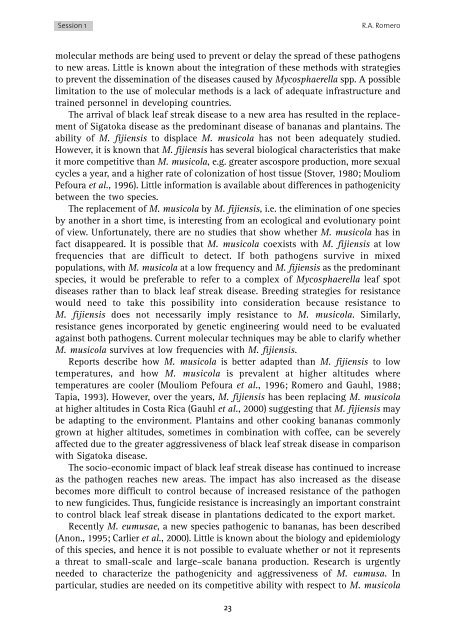Mycosphaerella leaf spot diseases of bananas - CBS
Mycosphaerella leaf spot diseases of bananas - CBS
Mycosphaerella leaf spot diseases of bananas - CBS
Create successful ePaper yourself
Turn your PDF publications into a flip-book with our unique Google optimized e-Paper software.
Session 1<br />
R.A. Romero<br />
molecular methods are being used to prevent or delay the spread <strong>of</strong> these pathogens<br />
to new areas. Little is known about the integration <strong>of</strong> these methods with strategies<br />
to prevent the dissemination <strong>of</strong> the <strong>diseases</strong> caused by <strong>Mycosphaerella</strong> spp. A possible<br />
limitation to the use <strong>of</strong> molecular methods is a lack <strong>of</strong> adequate infrastructure and<br />
trained personnel in developing countries.<br />
The arrival <strong>of</strong> black <strong>leaf</strong> streak disease to a new area has resulted in the replacement<br />
<strong>of</strong> Sigatoka disease as the predominant disease <strong>of</strong> <strong>bananas</strong> and plantains. The<br />
ability <strong>of</strong> M. fijiensis to displace M. musicola has not been adequately studied.<br />
However, it is known that M. fijiensis has several biological characteristics that make<br />
it more competitive than M. musicola, e.g. greater ascospore production, more sexual<br />
cycles a year, and a higher rate <strong>of</strong> colonization <strong>of</strong> host tissue (Stover, 1980; Mouliom<br />
Pefoura et al., 1996). Little information is available about differences in pathogenicity<br />
between the two species.<br />
The replacement <strong>of</strong> M. musicola by M. fijiensis, i.e. the elimination <strong>of</strong> one species<br />
by another in a short time, is interesting from an ecological and evolutionary point<br />
<strong>of</strong> view. Unfortunately, there are no studies that show whether M. musicola has in<br />
fact disappeared. It is possible that M. musicola coexists with M. fijiensis at low<br />
frequencies that are difficult to detect. If both pathogens survive in mixed<br />
populations, with M. musicola at a low frequency and M. fijiensis as the predominant<br />
species, it would be preferable to refer to a complex <strong>of</strong> <strong>Mycosphaerella</strong> <strong>leaf</strong> <strong>spot</strong><br />
<strong>diseases</strong> rather than to black <strong>leaf</strong> streak disease. Breeding strategies for resistance<br />
would need to take this possibility into consideration because resistance to<br />
M. fijiensis does not necessarily imply resistance to M. musicola. Similarly,<br />
resistance genes incorporated by genetic engineering would need to be evaluated<br />
against both pathogens. Current molecular techniques may be able to clarify whether<br />
M. musicola survives at low frequencies with M. fijiensis.<br />
Reports describe how M. musicola is better adapted than M. fijiensis to low<br />
temperatures, and how M. musicola is prevalent at higher altitudes where<br />
temperatures are cooler (Mouliom Pefoura et al., 1996; Romero and Gauhl, 1988;<br />
Tapia, 1993). However, over the years, M. fijiensis has been replacing M. musicola<br />
at higher altitudes in Costa Rica (Gauhl et al., 2000) suggesting that M. fijiensis may<br />
be adapting to the environment. Plantains and other cooking <strong>bananas</strong> commonly<br />
grown at higher altitudes, sometimes in combination with c<strong>of</strong>fee, can be severely<br />
affected due to the greater aggressiveness <strong>of</strong> black <strong>leaf</strong> streak disease in comparison<br />
with Sigatoka disease.<br />
The socio-economic impact <strong>of</strong> black <strong>leaf</strong> streak disease has continued to increase<br />
as the pathogen reaches new areas. The impact has also increased as the disease<br />
becomes more difficult to control because <strong>of</strong> increased resistance <strong>of</strong> the pathogen<br />
to new fungicides. Thus, fungicide resistance is increasingly an important constraint<br />
to control black <strong>leaf</strong> streak disease in plantations dedicated to the export market.<br />
Recently M. eumusae, a new species pathogenic to <strong>bananas</strong>, has been described<br />
(Anon., 1995; Carlier et al., 2000). Little is known about the biology and epidemiology<br />
<strong>of</strong> this species, and hence it is not possible to evaluate whether or not it represents<br />
a threat to small-scale and large–scale banana production. Research is urgently<br />
needed to characterize the pathogenicity and aggressiveness <strong>of</strong> M. eumusa. In<br />
particular, studies are needed on its competitive ability with respect to M. musicola<br />
23

















